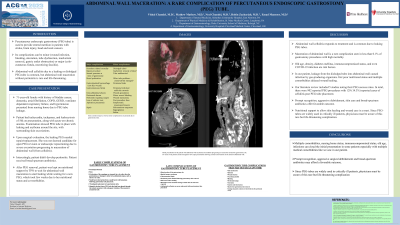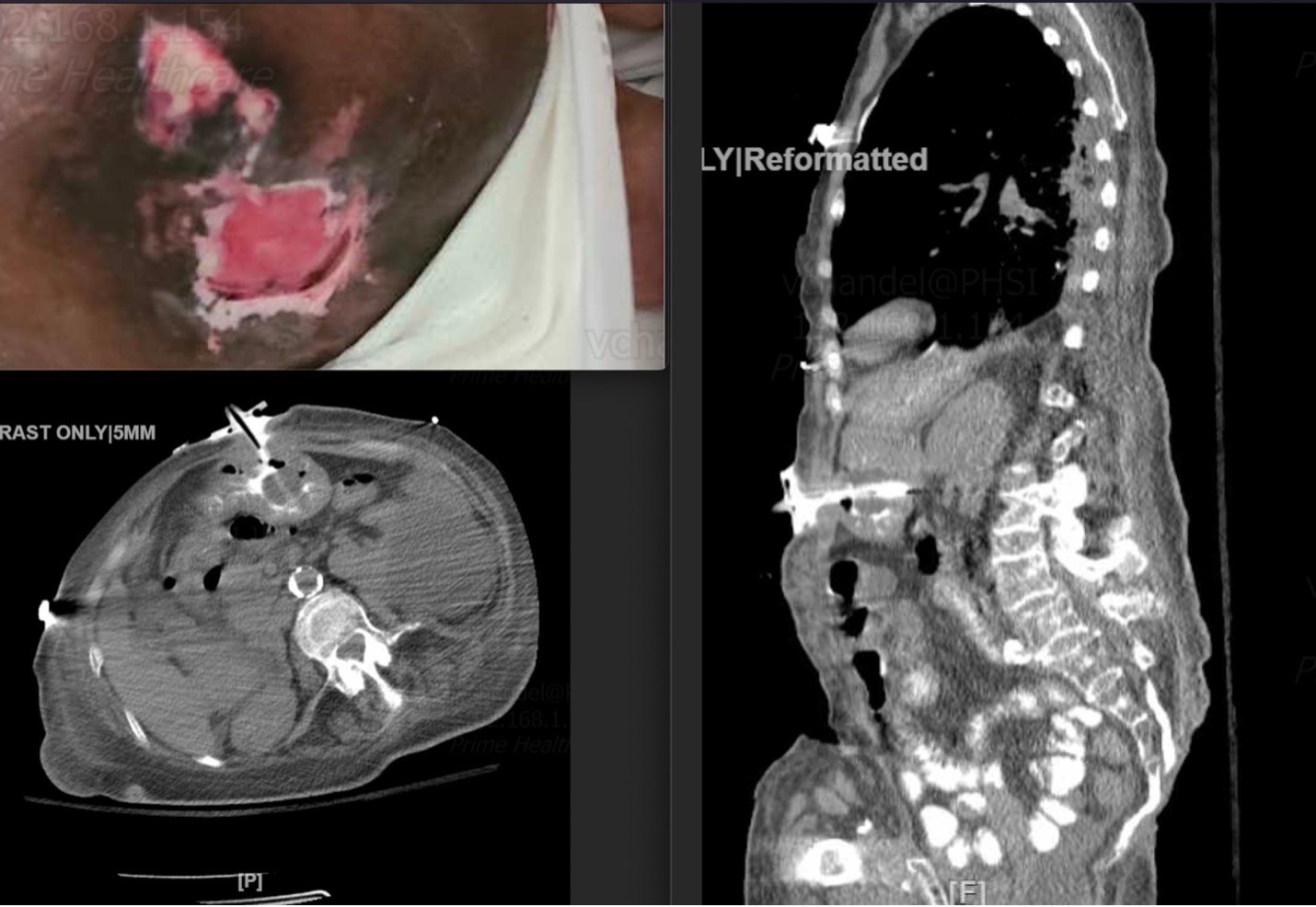Sunday Poster Session
Category: Stomach
P1408 - Abdominal Wall Maceration: A Rare Complication of Percutaneous Endoscopic Gastrostomy Tube
Sunday, October 22, 2023
3:30 PM - 7:00 PM PT
Location: Exhibit Hall

Has Audio

Vishal Chandel, MD
Suburban Community Hospital
Feasterville-Trevose, PA
Presenting Author(s)
Vishal Chandel, MD1, Mathew Mathew, MD2, Robin Zachariah, MD3, Neel Chandel, MD4, Emad Mansoor, MD5
1Suburban Community Hospital, Feasterville-Trevose, PA; 2Suburban Community Hospital, Media, PA; 3Duke University Hospital, Durham, NC; 4St. Mary Medical Center, Feasterville-tTevose, PA; 5Case Western Reserve University / University Hospitals, Cleveland, OH
Introduction: Percutaneous endoscopic gastrostomy (PEG-tube) is used to provide enteral nutrition in patients with stroke, brain injury, head and neck cancers. Its complications can be minor (wound infection, bleeding, ulceration, tube dysfunction, inadvertent removal, gastric outlet obstruction) or major (colo-cutaneous fistula, necrotizing fasciitis). Abdominal wall cellulitis due to a leaking or dislodged PEG-tube is common, but abdominal wall maceration without peritonitis is rare and life-threatening.
Case Description/Methods: 71-year-old female with history of bladder cancer, dementia, atrial fibrillation, COPD, GERD, ventilator dependent respiratory failure, and hypertension presented from nursing home due to PEG tube leakage. Patient had tachycardia, tachypnea, and leukocytosis of 56k on presentation, along with acute-on-chronic anemia. Examination showed PEG tube in place with leaking and erythema around the site, with surrounding skin excoriations. Upon surgical evaluation, the leaking PEG needed repair/replacement. She was not deemed candidate for open PEG revision or endoscopic repositioning due to severe excoriation progressing to maceration of abdominal wall (from cellulitis). Interestingly, patient didn't develop peritonitis. Patient received broad spectrum antibiotics. After PEG removal, patient was kept on nutritional support by TPN to wait for abdominal wall maceration to start healing while waiting for a new PEG, which took few weeks due to her nutritional status and co-morbidities.
Discussion: Abdominal wall cellulitis responds to treatment and is common due to leaking PEG tubes. Maceration of abdominal wall is a rare complication seen in less than 0.1% of gastrostomy procedures with high mortality. Old age, obesity, diabetes mellitus, immunocompromised status, and even COVID-19 infection are risk factors. In our patient, leakage from the dislodged tube into abdominal wall caused infection by gas-producing organisms. Her poor nutritional status and multiple comorbidities delayed wound healing. Our literature review included 5 studies noting their PEG success rates. In total, there were 902 reported PEG procedures with 129 (14.3%) reported cases of cellulitis post PEG tube placement. Prompt recognition, aggressive debridement, skin care and broad-spectrum antibiotics offer favorable outcome. Nutritional support to allow skin healing and wound care is a must. Since PEG-tubes are widely used in critically ill patients, physicians must be aware of this rare but life-threatening complication.

Disclosures:
Vishal Chandel, MD1, Mathew Mathew, MD2, Robin Zachariah, MD3, Neel Chandel, MD4, Emad Mansoor, MD5. P1408 - Abdominal Wall Maceration: A Rare Complication of Percutaneous Endoscopic Gastrostomy Tube, ACG 2023 Annual Scientific Meeting Abstracts. Vancouver, BC, Canada: American College of Gastroenterology.
1Suburban Community Hospital, Feasterville-Trevose, PA; 2Suburban Community Hospital, Media, PA; 3Duke University Hospital, Durham, NC; 4St. Mary Medical Center, Feasterville-tTevose, PA; 5Case Western Reserve University / University Hospitals, Cleveland, OH
Introduction: Percutaneous endoscopic gastrostomy (PEG-tube) is used to provide enteral nutrition in patients with stroke, brain injury, head and neck cancers. Its complications can be minor (wound infection, bleeding, ulceration, tube dysfunction, inadvertent removal, gastric outlet obstruction) or major (colo-cutaneous fistula, necrotizing fasciitis). Abdominal wall cellulitis due to a leaking or dislodged PEG-tube is common, but abdominal wall maceration without peritonitis is rare and life-threatening.
Case Description/Methods: 71-year-old female with history of bladder cancer, dementia, atrial fibrillation, COPD, GERD, ventilator dependent respiratory failure, and hypertension presented from nursing home due to PEG tube leakage. Patient had tachycardia, tachypnea, and leukocytosis of 56k on presentation, along with acute-on-chronic anemia. Examination showed PEG tube in place with leaking and erythema around the site, with surrounding skin excoriations. Upon surgical evaluation, the leaking PEG needed repair/replacement. She was not deemed candidate for open PEG revision or endoscopic repositioning due to severe excoriation progressing to maceration of abdominal wall (from cellulitis). Interestingly, patient didn't develop peritonitis. Patient received broad spectrum antibiotics. After PEG removal, patient was kept on nutritional support by TPN to wait for abdominal wall maceration to start healing while waiting for a new PEG, which took few weeks due to her nutritional status and co-morbidities.
Discussion: Abdominal wall cellulitis responds to treatment and is common due to leaking PEG tubes. Maceration of abdominal wall is a rare complication seen in less than 0.1% of gastrostomy procedures with high mortality. Old age, obesity, diabetes mellitus, immunocompromised status, and even COVID-19 infection are risk factors. In our patient, leakage from the dislodged tube into abdominal wall caused infection by gas-producing organisms. Her poor nutritional status and multiple comorbidities delayed wound healing. Our literature review included 5 studies noting their PEG success rates. In total, there were 902 reported PEG procedures with 129 (14.3%) reported cases of cellulitis post PEG tube placement. Prompt recognition, aggressive debridement, skin care and broad-spectrum antibiotics offer favorable outcome. Nutritional support to allow skin healing and wound care is a must. Since PEG-tubes are widely used in critically ill patients, physicians must be aware of this rare but life-threatening complication.

Figure: ABDOMINAL WALL CELLULITIS LEADING TO MACERATION WITHOUT PERITONITIS DUE TO PEG LEAK
Disclosures:
Vishal Chandel indicated no relevant financial relationships.
Mathew Mathew indicated no relevant financial relationships.
Robin Zachariah indicated no relevant financial relationships.
Neel Chandel indicated no relevant financial relationships.
Emad Mansoor indicated no relevant financial relationships.
Vishal Chandel, MD1, Mathew Mathew, MD2, Robin Zachariah, MD3, Neel Chandel, MD4, Emad Mansoor, MD5. P1408 - Abdominal Wall Maceration: A Rare Complication of Percutaneous Endoscopic Gastrostomy Tube, ACG 2023 Annual Scientific Meeting Abstracts. Vancouver, BC, Canada: American College of Gastroenterology.
